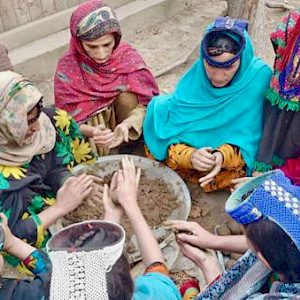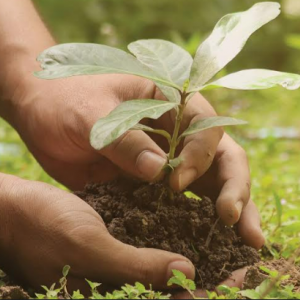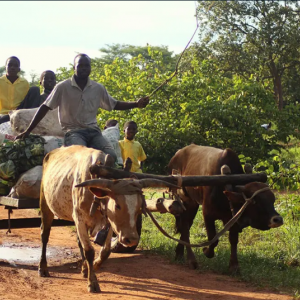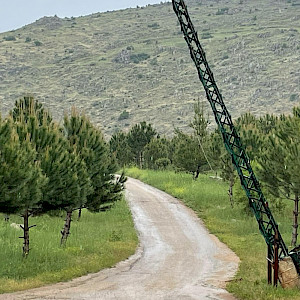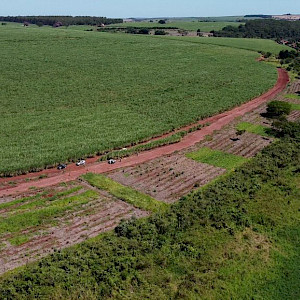Phoebe Weston’s November Guardian article 10 ways in which the climate crisis and nature loss are linked demonstrates the interrelation of the biodiversity and climate crises. From destroyed landscapes absorbing less carbon to extreme weather making land restoration even harder, the article clearly describes the importance of adequately addressing the looming crises with a holistic approach.
Biodiversity and climate change are intrinsically connected, and negative feedback loops do occur between them. But this interrelation also offers us opportunities to implement solutions that tackle both issues at once. Holistic landscape restoration is one such solution. Through restoring ecosystems, we can tackle interrelated global risks in an integrated way and transform negative trends into positive feedback loops. Taking a holistic approach to restoration – in other words, considering not only environmental but also social and economic impacts – can make ecosystems more climate-resilient and produce a whole host of other benefits for local communities.
There are incredible, innovative steps being taken by people all over the world to address the interrelated crises we face – to restore nature, mitigate climate change impacts, revitalise community and provide sustainable livelihoods. Let’s dive into the 10 ways in which holistic landscape restoration can tackle the interrelated issues of nature loss and climate crises, in direct response to Weston’s article above:
1. Fire can be used to mitigate wildfires
As the Guardian article describes, the climate crisis is exacerbating wildfire risks, with a quarter of the world’s landscapes now facing longer fire seasons. The destructive capacity of fire is something that many more of us will witness in our lifetimes. And yet, fire also has the capacity to regenerate ecosystems. Cultural burning is key to Aboriginal landscape management in Australia. Cool, controlled burns are used to clear underbrush and reduce the fuel load of dry vegetation, extinguishing the risk of intense wildfires. The practice of cultural burning is currently going through a revival. And with the expectation of a scorching summer in Australia, practices developed over millennia in harmony with the land will be key to mitigating extreme wildfires.
2. Managing biodiversity reduces wildfires
When land that was once heavily managed is abandoned, the resulting vegetation can create extreme wildfire risk. Experts suggest recent wildfires in Hawaii were so intense due to invasive grasses fuelling intense fires that were extremely difficult to extinguish. Actively managing land to promote biodiversity is an effective way to restore degraded or abandoned land and reduce wildfire risk. In Southeast Spain, wildfire risks in monoculture pine plantations are high during extended periods of drought. AlVelAl – Commonland’s local partner in Southeast Spain – reduces this risk and promotes biodiversity by selectively extracting pines. This technique creates space for the remaining pines to mature and allow rich native vegetation to regenerate naturally. Ecologist Fernando Bautista describes: “the ideal situation is to increase the canopy size of the trees that remain, to increase the area that is covered by bushes and grasses and to increase biodiversity while reducing fire risk in the region.”
3. Restored landscapes store more carbon
When landscapes are in a degraded state, the ability of vegetation to absorb carbon is reduced. Restoration techniques like regenerative agriculture, natural forest regeneration, conservation of biodiversity habitats, river restoration, and coastal rehabilitation lead to a growth of vegetation. One study from Ethiopia demonstrated that two decades of landscape restoration led to an increased uptake of soil organic carbon by almost 10%. As 75% of the world’s habitable lands are degraded, landscape restoration offers a tremendous opportunity to vegetate denuded soils and increase carbon sequestration: a powerful tool in mitigating the impacts of human-induced climate change.
4, Trees and forests cool down rising temperatures
Rising temperatures and ever-increasing heatwaves are having a disastrous impact on wildlife. While we are only just understanding how animals are reacting to these drastic changes, we do know techniques to help wildlife out. Forests provide cool microclimates for animals escaping the heat and planting trees in cities provides areas of shade for humans and urban creatures alike. Research demonstrates that the temperature of mini forests in urban areas is up to 20 degrees cooler than areas without trees. Reforestation also leads to cooler temperatures as clouds form more frequently over forests. Growing trees at scale therefore has the potential to cool the Earth’s atmosphere, as well directly providing shaded areas protected from the sun’s glare.
5. Landscape restoration supports ocean rehabilitation
The climate crisis severely impacts marine life because warming global temperatures result in ocean heatwaves. More than 1 billion marine creatures died in 2021 along Canada’s coast as temperatures reached 40 degrees Celsius. Measures to support the resilience of marine life should take place as much on land as at sea. Terrestrial and aquatic habitats are intricately linked, and landscape restoration supports marine life in various ways. Regenerative farming techniques reduce the need for pesticides and herbicides, reducing the runoff from harmful chemicals into watersheds and the ocean. Restored landscapes also provide more resources for local communities, reducing pressure on ocean resources.
6. Degraded marine life rebounds quickly
Ocean life is out of sight, so it’s harder for us to fully realise the depth and scale of marine degradation. Unfortunately, human activity has had a devasting impact on marine life through overfishing, oil spills, offshore drilling, plastic pollution and chemical run-off. Oceans play a key role in regulating climate, so ensuring that oceans remain rich and healthy is key to mitigating climate change. Fortunately, marine habitats rebound from degradation quickly and scientists suggest that within 30 years, the world’s oceans could be back to their former glory if we implement sufficient measures now. Some known ways to regenerate underwater life are through kelp and sea grass restoration. These practices lead to increased carbon sequestration while providing sanctuaries for aquatic biodiversity.
7. Biodiversity boosts carbon sequestration and storage
Healthy ecosystems are an entangled tapestry of life, and we are now understanding the critical role that biodiversity can play in climate change mitigation. Wildlife shapes the functioning of ecosystems, impacting processes like nutrient cycling and surface water evaporation. Animating the carbon cycle (ACC) is a concept promoted by a group of scientists, economists and conservation groups championing the idea that healthy wildlife populations forming part of functioning ecosystems leads to increased carbon sequestration. Beavers dramatically reshape their environments through building dams and creating wetlands, leading to an uptake in carbon sequestration. Herd species like wildebeest travel vast distances eating grass and converting it into dung, storing carbon in the soil. By looking at the bigger picture of how wildlife impacts plants and ecosystems, we start to better understand the role that rewilding and reintroductions of animal species can play in mitigating climate change.
8. Nature-based solutions improve resilience
Meteorologists predict more frequent extreme weather events because of climate change. Nature-based solutions are important to improving resilience to and recovery after extreme weather events. Solutions like restoring mangrove forests generate at least 28% more added value than built infrastructure like flood barriers, dams and storm drains. When mangrove forests thrive along coastlines, they provide a resilient natural infrastructure that shore up coastlines and reduce the impact of extreme weather events like cyclones, hurricanes and tsunamis, all while providing a rich aquatic ecosystem that nourishes biodiversity and people. With climate change making extreme weather events more frequent, landscape restoration is a key solution to keeping people and other creatures safe.
9. Creating and supporting community is key to landscape restoration
Landscape restoration provides diverse solutions to interrelated crises, while also incentivising community creation. Research shows that successful landscape restoration depends on creating “Social Alliances”. The process of social alliances requires people to set aside their differences, focus on what they have in common, and collaborate on a project that transcends any one organisation or individual. A powerful example of community creation is the development of La Junquera, a regenerative farm in Sothern Spain. Once an abandoned village, the La Junquera village is now home to a bustling community of regenerative entrepreneurs, researchers, students and practitioners working towards landscape restoration in a Mediterranean context.
10. Our understanding of how to feed the world in harmony with nature is growing
Farming worldwide contributes to more than 30% of all greenhouse gas emissions. As awareness spreads about the threats of conventional agriculture on soil and the environment more and more people are choosing to go regenerative. This year 6,500 people attended Groundswell – a regenerative agriculture festival in the UK – up from 400 in 2016. The regenerative agriculture movement is on the rise as even conventional farmers begin to adopt practices. While some proponents of regenerative agriculture fear that coorporations are greenwashing the regenerative movement, historic agreements like the EU Nature Restoration Law will only support the growth of feeding people in harmony with nature at scale.


